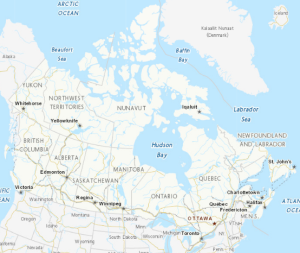FluWatch report: January 12 to 18, 2020 (week 03)
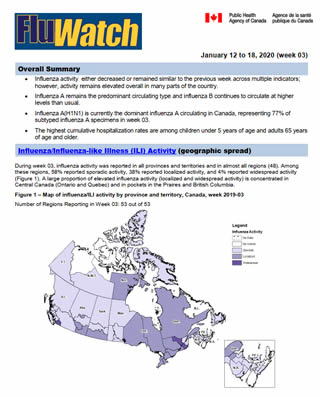
Download the alternative format
(PDF format, 737 KB, 13 pages)
Organization: Public Health Agency of Canada
Date published: 2020-01-24
Related Topics
Overall Summary
- Influenza activity either decreased or remained similar to the previous week across multiple indicators; however, activity remains elevated overall in many parts of the country.
- Influenza A remains the predominant circulating type and influenza B continues to circulate at higher levels than usual.
- Influenza A(H1N1) is currently the dominant influenza A circulating in Canada, representing 77% of subtyped influenza A specimens in week 03.
- The highest cumulative hospitalization rates are among children under 5 years of age and adults 65 years of age and older.
On this page
- Influenza/ILI Activity (geographic spread)
- Laboratory Confirmed Influenza Detections
- Syndromic/Influenza-like Illness Surveillance
- FluWatchers
- Influenza Outbreak Surveillance
- Severe Outcomes Influenza Surveillance
- Influenza Strain Characterizations
- Antiviral Resistance
- Vaccine Monitoring
- Provincial and International Influenza Reports
Influenza/Influenza-like Illness (ILI) Activity (geographic spread)
During week 03, influenza activity was reported in all provinces and territories and in almost all regions (48). Among these regions, 58% reported sporadic activity, 38% reported localized activity, and 4% reported widespread activity (Figure 1). A large proportion of elevated influenza activity (localized and widespread activity) is concentrated in Central Canada (Ontario and Quebec) and in pockets in the Praires and British Columbia.
Figure 1 – Map of influenza/ILI activity by province and territory, Canada, week 2020-03
Number of Regions Reporting in Week 03: 53 out of 53

Figure 1 - Text equivalent
| Province | Influenza Surveillance Region | Activity Level |
|---|---|---|
| N.L. | Eastern | Sporadic |
| N.L. | Labrador-Grenfell | No Activity |
| N.L. | Central | Sporadic |
| N.L. | Western | Sporadic |
| P.E.I. | Prince Edward Island | Sporadic |
| N.S. | Zone 1 - Western | No Activity |
| N.S. | Zone 2 - Northern | Sporadic |
| N.S. | Zone 3 - Eastern | No Activity |
| N.S. | Zone 4 - Central | Sporadic |
| N.B. | Region 1 | Sporadic |
| N.B. | Region 2 | Sporadic |
| N.B. | Region 3 | Sporadic |
| N.B. | Region 4 | Sporadic |
| N.B. | Region 5 | Localized |
| N.B. | Region 6 | Sporadic |
| N.B. | Region 7 | Sporadic |
| Que. | Nord-est | Localized |
| Que. | Québec et Chaudieres-Appalaches | Sporadic |
| Que. | Centre-du-Québec | Widespread |
| Que. | Montréal et Laval | Localized |
| Que. | Ouest-du-Québec | Localized |
| Que. | Montérégie | Localized |
| Ont. | Central East | Localized |
| Ont. | Central West | Localized |
| Ont. | Eastern | Localized |
| Ont. | North East | Localized |
| Ont. | North West | Localized |
| Ont. | South West | Localized |
| Ont. | Toronto | Localized |
| Man. | Northern Regional | Sporadic |
| Man. | Prairie Mountain | Sporadic |
| Man. | Interlake-Eastern | Sporadic |
| Man. | Winnipeg | Localized |
| Man. | Southern Health | Sporadic |
| Sask. | North | Sporadic |
| Sask. | Central | Sporadic |
| Sask. | South | Localized |
| Alta. | North Zone | Sporadic |
| Alta. | Edmonton | Localized |
| Alta. | Central Zone | Sporadic |
| Alta. | Calgary | Localized |
| Alta. | South Zone | Localized |
| B.C. | Interior | Sporadic |
| B.C. | Fraser | Widespread |
| B.C. | Vancouver Coastal | Sporadic |
| B.C. | Vancouver Island | Sporadic |
| B.C. | Northern | Sporadic |
| Y.T. | Yukon | Sporadic |
| N.W.T. | North | No Activity |
| N.W.T. | South | Sporadic |
| Nvt. | Qikiqtaaluk | Sporadic |
| Nvt. | Kivalliq | Localized |
| Nvt. | Kitimeot | No Activity |
Laboratory-Confirmed Influenza Detections
In week 03, the percentage of laboratory tests positive for influenza was similar to the previous three weeks. Influenza A and B continue to co-circulate. Among subtyped influenza A detections, the proportion of A(H1N1) has continued to increase.
The following results were reported from sentinel laboratories across Canada (Figures 2 and 3):
- The percentage of tests positive for influenza was similar to the previous three weeks at 26%. While this is slightly higher than the average (23%) for week 03 over the past five seasons, the plateau suggests that we are in the peak of laboratory detections.
- The percentage of tests positive for influenza A has increased only slightly over the past four weeks, from 15% in week 52 to 16% in week 03.
- The percentage of tests positive for influenza B was interrupted in its recent decline, increasing slightly from 9% in week 02 to 10% in week 03. This continues to be three times greater than the average (3.6%) for this time of year.
- Among subtyped influenza A detections, the proportion of A(H1N1) increased from 75% in week 02 to 77% in week 03.
To date this season (weeks 35 to 03), 20,432 laboratory detections of influenza were reported:
- 59% (12,149) were influenza A.
- Among subtyped influenza A detections (3 461), A(H1N1) is now the predominant subtype overall this season (56%), due to the increase in A(H1N1) detections in recent weeks.
Detailed information on age and type/subtype has been received for 15,398 laboratory-confirmed influenza cases (Table 1). To date this season (weeks 35 to 03):
- Among cases of influenza A(H3N2) (1,324), the largest proportion were in adults 65 years of age and older (47%).
- Cases of influenza B (6,806) were primarily in younger age groups; 55% of cases were under 20 years of age and 32% between 20 and 44 years of age.
- Among cases of influenza A(H1N1) (1,226), 32% of cases were in adults 65 years of age and older, with nearly equal proportions in adults 20-44 years (26%) and 45-64 years (25%).
For more detailed weekly and cumulative influenza data, see the text descriptions for Figures 2 and 3 or the Respiratory Virus Detections in Canada Report.
Figure 2 - Number of positive influenza tests and percentage of tests positive, by type, subtype and report week, Canada, weeks 2019-35 to 2020-03
Number of Laboratories Reporting in Week 03: 36 out of 36

The shaded area indicates weeks where the positivity rate was at least 5% and a minimum of 15 positive tests were observed, signalling the period of seasonal influenza activity.
Figure 2 - Text equivalent
| Surveillance Week | A(Unsubtyped) | A(H3N2) | A(H1N1)pdm09 | Influenza B | Percent Positive A | Percent Positive B |
|---|---|---|---|---|---|---|
| 35 | 10 | 16 | 0 | 2 | 1.3 | 0.1 |
| 36 | 11 | 13 | 2 | 2 | 1.1 | 0.1 |
| 37 | 5 | 17 | 2 | 5 | 0.9 | 0.2 |
| 38 | 11 | 15 | 3 | 6 | 1.0 | 0.2 |
| 39 | 11 | 21 | 2 | 3 | 1.0 | 0.1 |
| 40 | 34 | 9 | 1 | 2 | 1.2 | 0.1 |
| 41 | 34 | 18 | 0 | 5 | 1.4 | 0.1 |
| 42 | 54 | 12 | 1 | 14 | 1.6 | 0.3 |
| 43 | 44 | 13 | 7 | 17 | 1.6 | 0.3 |
| 44 | 43 | 23 | 16 | 17 | 1.8 | 0.3 |
| 45 | 57 | 57 | 20 | 39 | 2.2 | 0.7 |
| 46 | 82 | 43 | 23 | 77 | 2.7 | 1.4 |
| 47 | 118 | 49 | 33 | 124 | 3.1 | 1.9 |
| 48 | 225 | 67 | 42 | 223 | 4.9 | 3.2 |
| 49 | 281 | 79 | 41 | 336 | 5.3 | 4.1 |
| 50 | 463 | 100 | 73 | 654 | 7.7 | 8.0 |
| 51 | 794 | 149 | 169 | 1094 | 10.6 | 10.4 |
| 52 | 1223 | 267 | 197 | 1439 | 15.0 | 12.7 |
| 1 | 1620 | 261 | 431 | 1533 | 15.8 | 10.3 |
| 2 | 1691 | 165 | 493 | 1463 | 15.8 | 9.4 |
| 3 | 1558 | 116 | 395 | 1368 | 16.2 | 10.3 |
Figure 3 – Distribution of positive influenza specimens by type/subtype and province/territoryFootnote *, Canada, weeks 2019-35 to 2020-03

- Footnote *
-
Specimens from NWT, YT, and Nvt are sent to reference laboratories in other provinces.
Figure 3 - Text equivalent
| ProvincesTable Figure 3 - Footnote 1 | Cumulative (August 25, 2019 to January 18, 2020) | |||||
|---|---|---|---|---|---|---|
| A Total | A(H1N1) | A(H3N2) | A(UnS)Table Figure 3 - Footnote 3 | B Total | A & B Total | |
| B.C. | 886 | 146 | 227 | 178 | 593 | 1479 |
| Alta. | 1773 | 382 | 903 | 488 | 2070 | 3843 |
| Sask. | 618 | 0 | 0 | 618 | 179 | 797 |
| Man. | 462 | 63 | 59 | 340 | 547 | 1009 |
| Ont. | 3346 | 1308 | 272 | 1766 | 750 | 4096 |
| Que. | 4764 | 0 | 0 | 4764 | 3849 | 8613 |
| N.B. | 151 | 23 | 9 | 119 | 211 | 362 |
| N.S. | 32 | 0 | 0 | 32 | 23 | 55 |
| P.E.I. | 10 | 0 | 0 | 10 | 12 | 22 |
| N.L. | 51 | 4 | 24 | 23 | 33 | 84 |
| Y.T. | 22 | 4 | 8 | 10 | 2 | 24 |
| N.W.T | 30 | 21 | 8 | 1 | 11 | 41 |
| Nvt. | 4 | 0 | 0 | 4 | 3 | 7 |
| Canada | 12149 | 1951 | 1510 | 8353 | 8283 | 20432 |
| PercentageTable Figure 3 - Footnote 2 | 59% | 16% | 12% | 69% | 41% | 100% |
|
||||||
| Age groups (years) |
Cumulative (August 25, 2019 to January 18, 2020) | ||||||
|---|---|---|---|---|---|---|---|
| Influenza A | B | Influenza A and B | |||||
| A Total | A(H1N1) | A(H3N2) | A (Un subtyped)Table 1 Footnote 1 | Total | # | % | |
| 0-4 | 1242 | 133 | 132 | 977 | 1452 | 2694 | 17% |
| 5-19 | 789 | 79 | 165 | 545 | 2259 | 3048 | 20% |
| 20-44 | 1640 | 314 | 198 | 1128 | 2202 | 3842 | 25% |
| 45-64 | 1597 | 305 | 208 | 1084 | 382 | 1979 | 13% |
| 65+ | 3324 | 395 | 621 | 2308 | 511 | 3835 | 25% |
| Total | 8592 | 1226 | 1324 | 6042 | 6806 | 15398 | 100% |
|
|||||||
Syndromic / Influenza-like Illness Surveillance
Healthcare Professionals Sentinel Syndromic Surveillance
In week 03, 2.1% of visits to healthcare professionals were due to influenza-like illness (ILI) which is the average for this time of year (Figure 4).
Figure 4 – Percentage of visits for ILI reported by sentinels by report week, Canada, weeks 2019-35 to 2020-03
Number of Sentinels Reporting in Week 03: 91

The shaded area represents the maximum and minimum percentage of visits for ILI reported by week from seasons 2014-2015 to 2018-2019
Figure 4 - Text equivalent
| Surveillance Week | 2019-20 | Average | Min | Max |
|---|---|---|---|---|
| 35 | 0.6% | 0.6% | 0.4% | 0.9% |
| 36 | 0.4% | 0.6% | 0.4% | 0.9% |
| 37 | 0.7% | 0.7% | 0.5% | 1.0% |
| 38 | 1.1% | 0.7% | 0.6% | 1.0% |
| 39 | 0.8% | 0.9% | 0.5% | 1.2% |
| 40 | 1.0% | 1.2% | 0.8% | 1.7% |
| 41 | 0.9% | 1.7% | 0.8% | 2.8% |
| 42 | 1.1% | 1.6% | 1.2% | 2.1% |
| 43 | 0.7% | 1.2% | 0.8% | 1.7% |
| 44 | 0.9% | 1.2% | 0.7% | 1.7% |
| 45 | 0.7% | 1.2% | 0.9% | 1.5% |
| 46 | 1.1% | 1.4% | 1.2% | 1.8% |
| 47 | 1.2% | 1.6% | 1.1% | 2.2% |
| 48 | 0.9% | 1.5% | 1.1% | 2.2% |
| 49 | 1.0% | 1.7% | 1.0% | 2.8% |
| 50 | 1.4% | 1.5% | 1.1% | 1.7% |
| 51 | 1.2% | 1.9% | 1.4% | 2.7% |
| 52 | 2.6% | 2.0% | 1.0% | 3.1% |
| 1 | 3.0% | 3.4% | 1.9% | 5.4% |
| 2 | 1.6% | 3.4% | 1.8% | 5.7% |
| 3 | 2.1% | 2.3% | 1.3% | 3.7% |
FluWatchers
The proportion of FluWatchers participants reporting symptoms of cough and fever increased slightly in week 03 compared to the previous week. In week 03, 3,222 participants reported to FluWatchers, of which 3.3% (106) reported symptoms of cough and fever (Figure 5).
Among the 106 participants who reported cough and fever:
- 25% consulted a healthcare professional;
- 76% reported days missed from work or school, resulting in a combined total of 282 missed days of work or school.
- 72% reported having been vaccinated for influenza this season.
If you are interested in becoming a FluWatcher, sign up today.
Figure 5 - Percentage of participants reporting fever and cough, Canada, weeks 2019-40 to 2020-03
Number of Participants Reporting in Week 03: 3,222

Figure 5 - Text equivalent
| Surveillance Week | % cough and fever |
|---|---|
| 40 | 2.2% |
| 41 | 1.8% |
| 42 | 1.7% |
| 43 | 2.2% |
| 44 | 1.6% |
| 45 | 1.4% |
| 46 | 1.2% |
| 47 | 1.5% |
| 48 | 1.7% |
| 49 | 2.2% |
| 50 | 2.1% |
| 51 | 2.6% |
| 52 | 4.1% |
| 1 | 4.3% |
| 2 | 3.1% |
| 3 | 3.3% |
Online Figure – Geographic distribution of FluWatchers participants reporting cough and fever, Canada, week 2020-03
Click on the map to access the link
Influenza Outbreak Surveillance
In week 03, the number of new laboratory-confirmed influenza outbreaks decreased. A total of 40 outbreaks were reported: 27 in long term care facilities, 10 in acute care facilities, and 27 in facilities categorized as 'other', which includes facilities such as private personal care homes, correctional facilities, and colleges/universities (Figure 6).
To date this season, a total of 421 laboratory-confirmed influenza outbreaks have been reported; 59% (249) in long-term care facilities, 28% (116) in facilities categorized as ‘other’, 12% (51) in acute care facilities, and 1% (5) in schools/daycares. Of the 393 outbreaks where influenza type was reported, 89% (351) were due to influenza A. Among the 179 outbreaks for which the influenza A subtype was reported, 59% (106) were associated with A(H3N2). Eight ILI outbreaks in schools/daycares have also been reported.
Figure 6 – Number of new outbreaks of laboratory-confirmed influenza by report week, Canada, weeks 2019-35 to 2020-03
Number of provinces and territories reporting in week 03: 13 out of 13

Figure 6 - Text equivalent
| Surveillance Week | Acute Care Facilities | Long Term Care Facilities | Other | Schools and Daycares | Remote and/or Isolated Communities |
|---|---|---|---|---|---|
| 35 | 0 | 0 | 0 | 0 | 0 |
| 36 | 0 | 0 | 0 | 0 | 0 |
| 37 | 0 | 0 | 0 | 0 | 0 |
| 38 | 0 | 1 | 0 | 0 | 0 |
| 39 | 0 | 1 | 0 | 0 | 0 |
| 40 | 0 | 2 | 0 | 0 | 0 |
| 41 | 0 | 2 | 1 | 0 | 0 |
| 42 | 1 | 0 | 0 | 0 | 0 |
| 43 | 0 | 0 | 1 | 0 | 0 |
| 44 | 0 | 0 | 1 | 0 | 0 |
| 45 | 0 | 2 | 4 | 0 | 0 |
| 46 | 1 | 4 | 0 | 0 | 0 |
| 47 | 0 | 2 | 1 | 1 | 0 |
| 48 | 1 | 6 | 2 | 2 | 0 |
| 49 | 2 | 8 | 1 | 1 | 0 |
| 50 | 3 | 10 | 4 | 1 | 0 |
| 51 | 4 | 14 | 11 | 0 | 0 |
| 52 | 4 | 35 | 15 | 0 | 0 |
| 1 | 16 | 59 | 38 | 0 | 0 |
| 2 | 9 | 76 | 34 | 0 | 0 |
| 3 | 10 | 27 | 3 | 0 | 0 |
Severe Outcomes Influenza Surveillance
Provincial/Territorial Influenza Hospitalizations and Deaths
To date this season, 946 influenza-associated hospitalizations were reported by participating provinces and territoriesFootnote †.
- 64% of the cases were associated with influenza A.
- Of the 498 cases for which subtype was reported, 75% were associated with influenza A(H3N2).
- The highest cumulative hospitalization rates up to week 03 were adults 65 years of age and older (32/100,000 population) and among children under 5 years of age (30/100,000 population).
Eighty-one ICU admissions and thirteen deaths have been reported.
- 57% of the ICU admissions and 77% of the deaths were associated with influenza A.
Figure 7 – Cumulative rates of influenza-associated hospitalizations by age-group and surveillance week, Canada, participating provinces and territoriesFootnote 1 weeks 2019-35 to 2020-03
Number of provinces and territories reporting in week 03: 9 out of 9

- Footnote ‡
-
Influenza-associated hospitalizations are reported by Alberta, Manitoba, New Brunswick, Newfoundland and Labrador, Northwest Territories, Nova Scotia, Prince Edward Island and Yukon. Only hospitalizations that require intensive medical care are reported by Saskatchewan.
Figure 7 - Text equivalent
| Surveillance Week | 0-4 yrs | 5-19 yrs | 20-44 yrs | 45-64 yrs | 65+ yrs |
|---|---|---|---|---|---|
| 35 | 0.0 | 0.0 | 0.0 | 0.0 | 0.0 |
| 36 | 0.0 | 0.0 | 0.0 | 0.0 | 0.2 |
| 37 | 0.0 | 0.0 | 0.0 | 0.1 | 0.2 |
| 38 | 0.0 | 0.0 | 0.0 | 0.1 | 0.4 |
| 39 | 0.2 | 0.0 | 0.0 | 0.1 | 0.6 |
| 40 | 0.2 | 0.0 | 0.0 | 0.1 | 0.8 |
| 41 | 0.4 | 0.2 | 0.1 | 0.2 | 1.1 |
| 42 | 0.8 | 0.2 | 0.1 | 0.2 | 1.3 |
| 43 | 1.0 | 0.2 | 0.2 | 0.3 | 1.6 |
| 44 | 1.5 | 0.2 | 0.2 | 0.5 | 2.1 |
| 45 | 1.9 | 0.4 | 0.4 | 0.8 | 2.8 |
| 46 | 1.9 | 0.4 | 0.6 | 1.1 | 3.3 |
| 47 | 3.1 | 0.6 | 0.8 | 1.5 | 4.6 |
| 48 | 5.0 | 1.1 | 1.0 | 1.6 | 5.7 |
| 49 | 7.1 | 1.9 | 1.3 | 1.9 | 7.5 |
| 50 | 11.1 | 3.0 | 1.8 | 2.2 | 10.0 |
| 51 | 14.3 | 3.7 | 2.5 | 3.4 | 13.3 |
| 52 | 18.5 | 5.6 | 3.6 | 4.5 | 18.8 |
| 1 | 25.8 | 6.2 | 4.2 | 5.9 | 25.9 |
| 2 | 29.0 | 7.0 | 4.7 | 6.9 | 29.9 |
| 3 | 30.0 | 7.3 | 5.0 | 7.4 | 31.6 |
Pediatric Influenza Hospitalizations and Deaths
In week 03, 81 pediatric (≤16 years of age) laboratory-confirmed influenza-associated hospitalizations were reported by the Immunization Monitoring Program Active (IMPACT) network (Figure 8). The weekly number of cases decreased for the second consecutive week but remains above the 5-year maximum in week 03.
The elevated number of cases in recent weeks is likely due to the concurrent circulation of influenza A and B this season. The number of influenza A-associated pediatric hospitalizations is similar to the average for this time of year. Influenza B usually circulates later in the season, in February or March. However, this season, the number of hospitalizations with influenza B is well above average compared to previous seasons, and occurring earlier in the season.
To date this season (weeks 35 to 03):
- 560 pediatric hospitalizations have been reported by the IMPACT network, of which 52% (289) were associated with influenza B and 49% (271) with influenza A.
- The largest proportion of hospitalizations (66%) were among children under 5 years of age (Figure 9).
- Among cases in children under 5 years of age (367), 54% were associated with influenza A, compared to cases in children 5 to 16 years of age (193), among whom 63% of cases were associated with influenza B.
- 78 ICU admissions were reported, of which 51% (40) were associated with influenza A.
- Less than five pediatric deaths have been reported.
Figure 8 – Number of pediatric (≤16 years of age) hospitalizations reported by the IMPACT network, by week, Canada, weeks 2019-35 to 2020-03

The shaded area represents the maximum and minimum number of cases reported by week from seasons 2014-15 to 2018-19
Figure 8 - Text equivalent
| Surveillance week | 2019-2020 | Average | Min | Max |
|---|---|---|---|---|
| 35 | 0 | 0 | 0 | 1 |
| 36 | 2 | 0 | 0 | 1 |
| 37 | 0 | 1 | 0 | 2 |
| 38 | 0 | 1 | 0 | 2 |
| 39 | 1 | 1 | 0 | 3 |
| 40 | 0 | 1 | 0 | 2 |
| 41 | 2 | 1 | 0 | 3 |
| 42 | 2 | 2 | 0 | 5 |
| 43 | 1 | 5 | 2 | 12 |
| 44 | 2 | 5 | 1 | 15 |
| 45 | 3 | 10 | 2 | 37 |
| 46 | 6 | 13 | 1 | 41 |
| 47 | 6 | 13 | 2 | 36 |
| 48 | 26 | 18 | 2 | 40 |
| 49 | 23 | 22 | 3 | 47 |
| 50 | 39 | 29 | 4 | 50 |
| 51 | 60 | 41 | 5 | 84 |
| 52 | 97 | 54 | 14 | 89 |
| 1 | 110 | 55 | 21 | 94 |
| 2 | 99 | 40 | 12 | 63 |
| 3 | 81 | 44 | 28 | 64 |

Figure 9 - Text Description
| Age Group | Total |
|---|---|
| 0-5 mo | 73 |
| 6-23 mo | 149 |
| 2-4 yr | 145 |
| 5-9 yr | 119 |
| 10-16 yr | 74 |
Adult Influenza Hospitalizations and Deaths
Surveillance of laboratory-confirmed influenza-associated adult (≥16 years of age) hospitalizations by the Canadian Immunization Research Network (CIRN) Serious Outcomes Surveillance (SOS) network began on November 1st for the 2019-20 season. In week 03, the number of cases decreased for the second consecutive week.
To date this season, 352 hospitalizations, 15 intensive care unit admissions, and six deaths have been reported (Figure 10). The majority of hospitalizations have been due to influenza A (88%), and among those subtyped (93) 91% were influenza A(H1N1). The largest proportion of hospitalizations are in adults 65-79 years of age (34%) and adults 80 years of age and older (32%) (Figure 11).
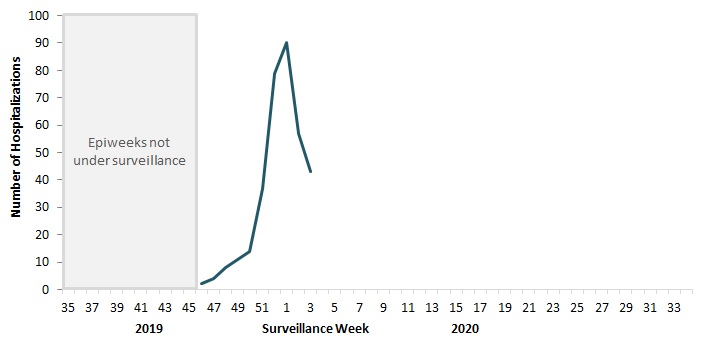
Figure 10 - Text Description
| Surveillance Week | Number of Hospitalizations |
|---|---|
| 35 | No data |
| 36 | No data |
| 37 | No data |
| 38 | No data |
| 39 | No data |
| 40 | No data |
| 41 | No data |
| 42 | No data |
| 43 | No data |
| 44 | No data |
| 45 | No data |
| 46 | 2 |
| 47 | 4 |
| 48 | 8 |
| 49 | 11 |
| 50 | 14 |
| 51 | 37 |
| 52 | 79 |
| 1 | 90 |
| 2 | 57 |
| 3 | 43 |
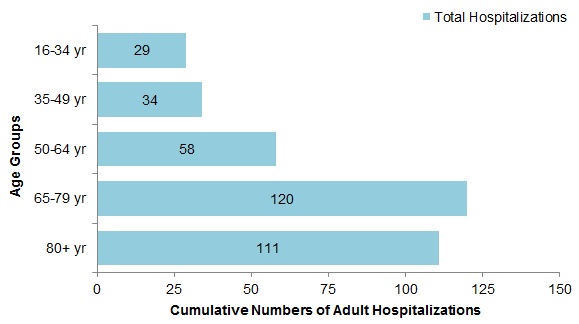
Figure 11 - Text Description
| Age Group | Total hospitalizations |
|---|---|
| 16-34 yr | 29 |
| 35-49 yr | 34 |
| 50-64 yr | 58 |
| 65-79 yr | 120 |
| 80+ yr | 111 |
Influenza Strain Characterizations
From September 1, 2019 to January 23, 2020, the National Microbiology Laboratory (NML) has characterized 456 influenza viruses (142 A(H3N2), 190 A(H1N1) and 124 influenza B) that were received from Canadian laboratories.
Influenza A(H3N2)
Over recent years, circulating strains of A(H3N2) have evolved, and are increasingly difficult to characterize by hemagglutination inhibition (HI) assay. Genetic characterization is established by sequencing the hemagglutinin (HA) gene of the influenza viruses to compare their genetic properties.
Antigenic Characterization:
Among the 38 influenza A(H3N2) viruses antigenically characterized to date, the majority (89%) showed reduced titer by HI assay to A Kansas/14/2017 using antiserum raised against egg-propagated A Kansas/14/2017. Four viruses were characterized as A Kansas/14/2017-like (Figure 12 a).
Genetic Characterization:
Nearly all (98%) of the 135 A(H3N2) viruses genetically characterized this season belonged to genetic group 3C.2a1b based on sequence analysis of the HA gene. Three viruses belonged to the genetic group 3C.3a (Figure 13).
Group 3C.2a1b viruses analysed represent:
- 74% (28 out of 31) viruses that were also antigenically characterized.
- 100% (104 out of 104) viruses which did not grow to sufficient hemagglutination titer for antigenic characterization by HI assay.
A/Kansas/14/2017 belongs to genetic group 3C.3a and is the influenza A(H3N2) component of the 2019-20 Northern Hemisphere influenza vaccine.
Influenza A(H1N1)
Among the 190 A(H1N1) viruses characterized to date, 62% were antigenically similar to A/Brisbane/02/2018 by HI testing using antiserum raised against egg-propagated A/Brisbane/02/2018 (Figure 12 b).
A/Brisbane/02/2018 is the influenza A(H1N1) component of the 2019-20 Northern Hemisphere influenza vaccine.
Influenza B
Among the 124 influenza B viruses antigenically characterized this season, the vast majority (122) belonged to the B/Victoria lineage. Two viruses were antigenically characterized as similar to B/Phuket/3073/2013 (B/Yamagata lineage).
The majority (89%, 108) of B/Victoria lineage viruses showed reduced titer by HI assay to B/Colorado/06/2017 using antiserum raised against cell culture-propagated B/Colorado/06/2017 (Figure 12 c).
Sequence analysis showed that 100% of the 105 B/Victoria lineage viruses showing reduced titre to B/Colorado/06/2017 had a three amino acid deletion (162-164) in the HA gene. Sequencing is pending for the remaining three viruses.
The recommended influenza B components for the 2019-20 Northern Hemisphere influenza vaccine are B/Colorado/06/2017 (Victoria lineage) and B/Phuket/3073/2013 (Yamagata lineage). B/Phuket/3073/2013 is included in the quadrivalent influenza vaccine.
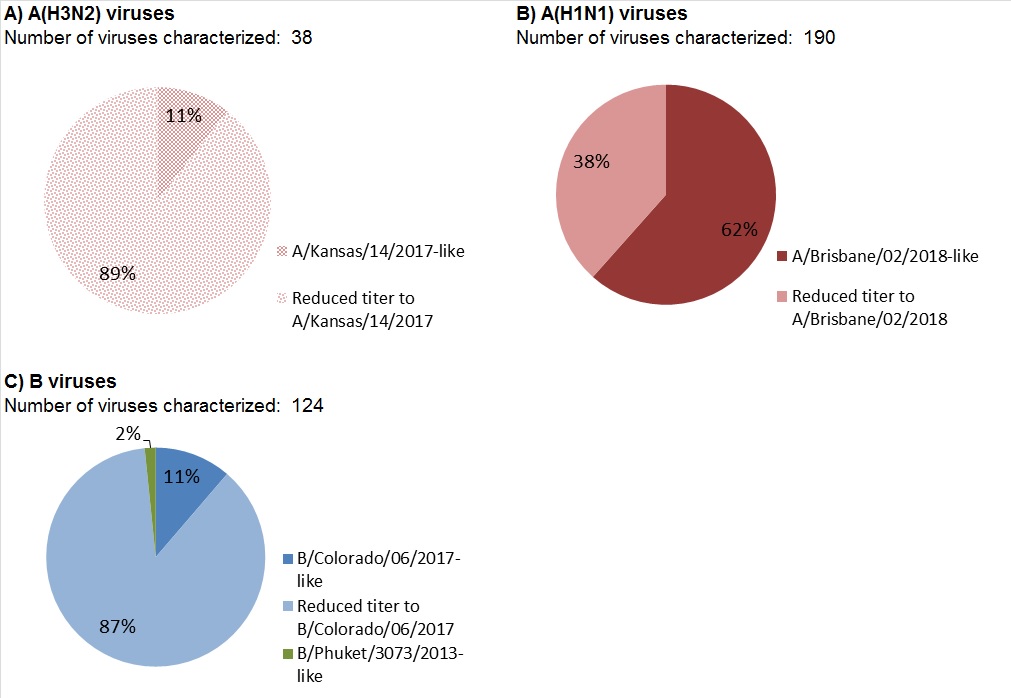
Figure 12 - Text Description
| Number of viruses characterized: 38 | ||
| Antigenic phenotype of A(H3N2) virus | Number of viruses | Percentage |
|---|---|---|
| A/Kansas/14/2017-like | 4 | 11% |
| Reduced titer to A/Kansas/14/2017 | 34 | 89% |
| Number of viruses characterized: 190 | ||
| Antigenic phenotype of A(H1N1) virus | Number of viruses | Percentage |
|---|---|---|
| A/Brisbane/02/2018-like | 117 | 62% |
| Reduced titer to A/Brisbane/02/2018 | 73 | 38% |
| Number of viruses characterized: 124 | ||
| Antigenic phenotype of influenza B virus | Number of viruses | Percentage |
|---|---|---|
| B/Colorado/06/2017-like | 14 | 11% |
| Reduced titer to B/Colorado/06/2017 | 108 | 87% |
| B/Phuket/3073/2013-like | 2 | 2% |
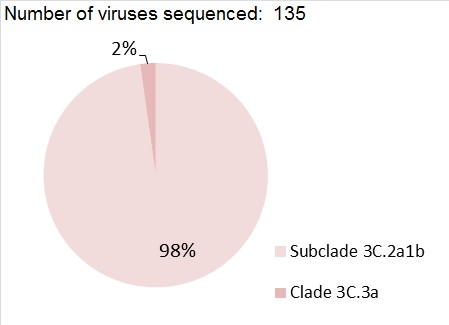
Figure 13 - Text Description
| Number of viruses sequenced: 135 | ||
| Genetic Clade of A(H3N2) virus | Number of viruses | Percentage |
|---|---|---|
| Subclade 3C.2a1b | 132 | 98% |
| Clade 3C.3a | 3 | 2% |
Antiviral Resistance
The National Microbiology Laboratory (NML) also tests influenza viruses received from Canadian laboratories for antiviral resistance. From September 1, 2019 to January 23, 2020, the following results were reported:
Oseltamivir:
277 influenza viruses (118 A(H3N2), 72 A(H1N1) and 87 B) were tested for resistance to oseltamivir:
- All influenza A(H3N2) and B viruses were sensitive to oseltamivir.
- Among the A(H1N1) viruses tested, 71 (99%) were sensitive to oseltamivir and one virus was resistant to oseltamivir with the H275Y mutation in the neuraminidase gene.
Zanamivir:
277 influenza viruses (118 A(H3N2), 72 A(H1N1) and 87 B) were tested for resistance to zanamivir:
- All influenza viruses tested were sensitive to zanamivir.
Amantadine:
High levels of resistance to amantadine persist among influenza A(H1N1) and influenza A(H3N2) viruses. All viruses tested this season were resistant.
Vaccine Monitoring
Vaccine monitoring refers to activities related to the monitoring of influenza vaccine coverage and effectiveness.
Vaccine Coverage
Influenza vaccine coverage estimates for the 2019-20 season are anticipated to be available in February or March 2020.
Vaccine Effectiveness
Influenza vaccine effectiveness estimates for the 2019-20 season are anticipated to be available in February or March 2020.
Notes
The data in the FluWatch report represent surveillance data available at the time of writing. All data are preliminary and may change as more reports are received.
To learn more about the FluWatch program, see the Overview of influenza monitoring in Canada page.
For more information on the flu, see our Flu (influenza) web page.
We would like to thank all the Fluwatch surveillance partners participating in this year's influenza surveillance program.
This report is available on the Government of Canada Influenza webpage.
Ce rapport est disponible dans les deux langues officielles.
Page details
- Date modified:
